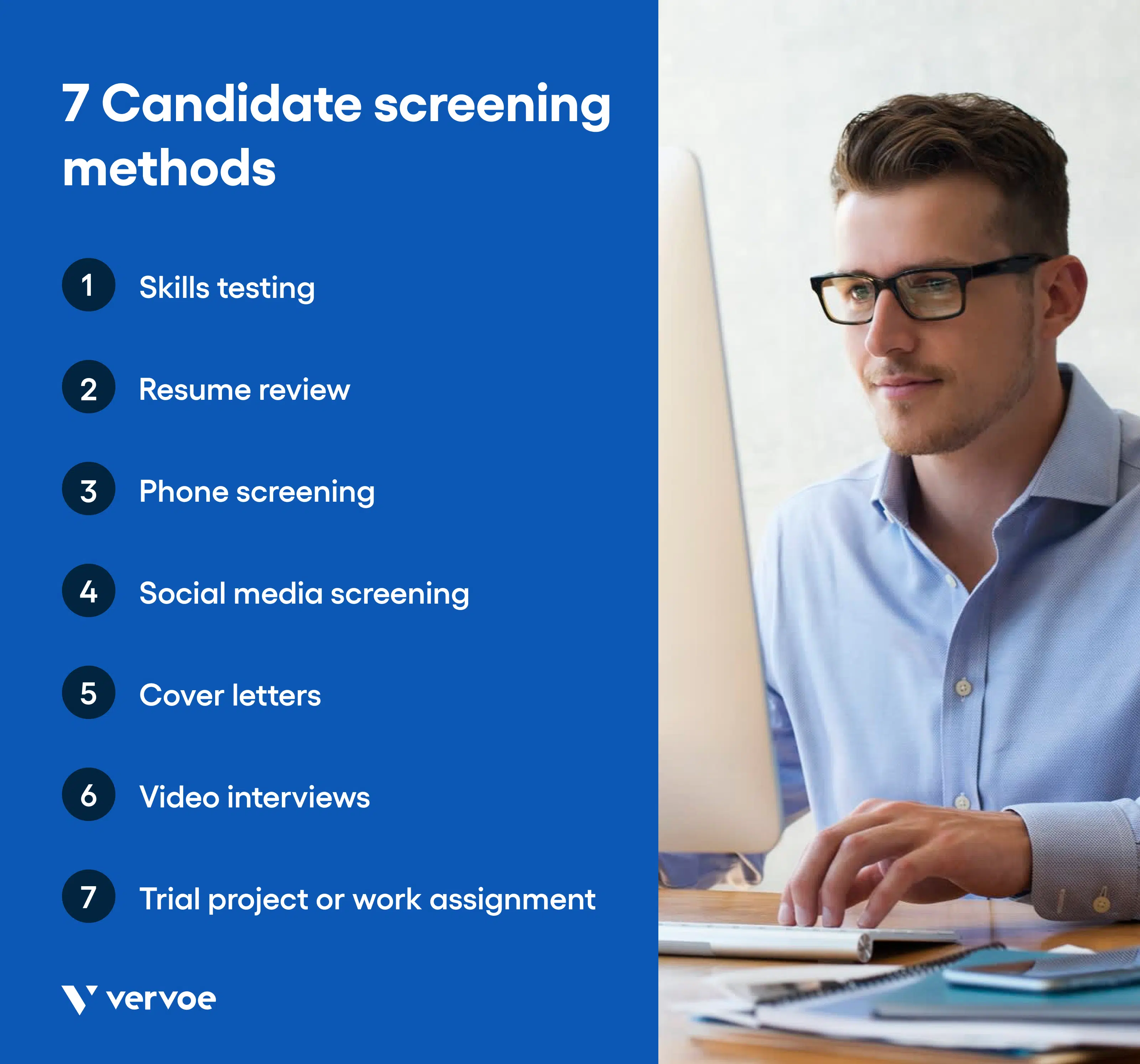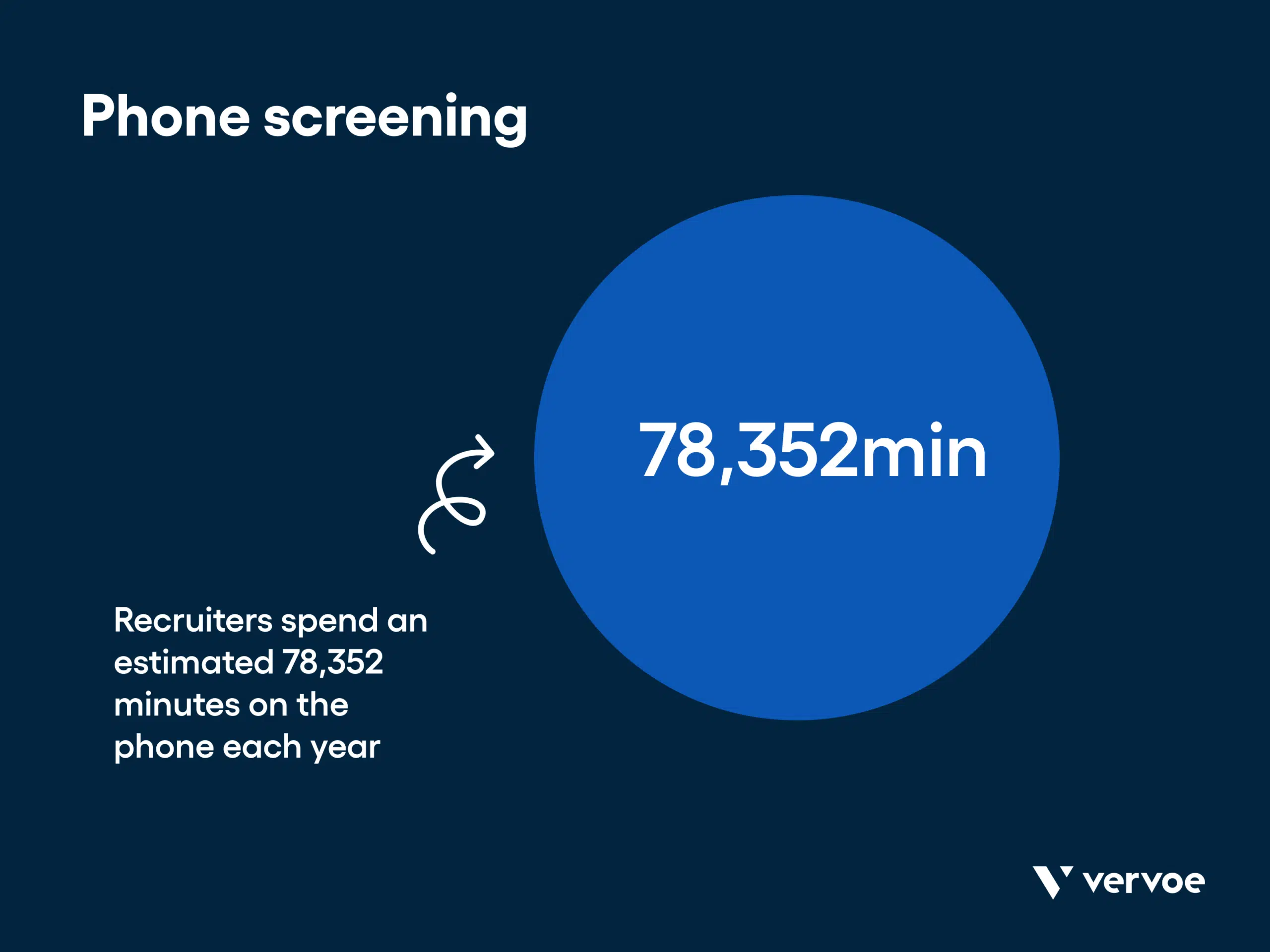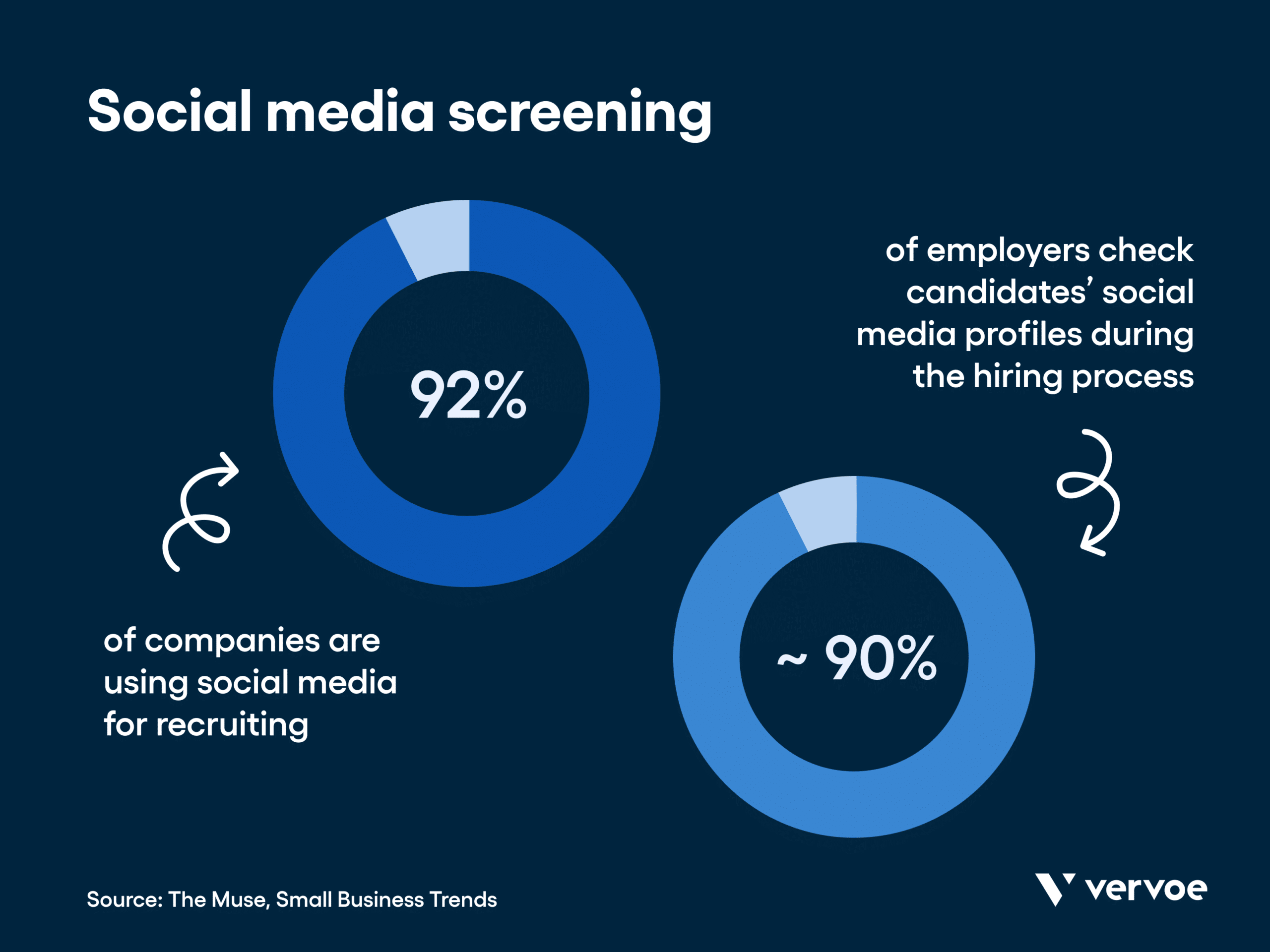The candidate screening process is integral to finding the best new hire for your open position. The screening process helps recruiters narrow their talent pipeline and zero in on the best candidates with whom to move forward in the hiring process. Ideally, candidate screening is streamlined, fair, and automated when possible.
One of the tricky parts of screening candidates in recruitment is keeping your applicants engaged. Recruiters are constantly warned that hiring the wrong candidate is an expensive and time-consuming mistake. As a result, it’s tempting to add as many job screening steps as possible to try to find the very best candidate the first time around. For candidates, however, jumping through all these hoops can be burdensome. The more screening criteria for candidates, the higher your attrition rate is likely to be.
In this guide, we’ll cover some of the benefits and drawbacks of different methods in the job screening process as well as some of the ways in which screening can provide a better experience for recruiters and candidates alike.
What is candidate screening?
Candidate screening refers to the process of determining if a candidate is qualified to continue through the hiring process based on their skills, experience, and expertise. Screening applicants is a part of the overall hiring process, coming before the interview stage and after you have collected résumés through a job ad or recruitment event.
An HR screening process allows you to create a shortlist of qualified individuals who have the potential to be successful at your organization. The goal of the candidate screening process in recruitment is to efficiently sort through the hundreds, or even thousands of résumés to identify the best candidates, foster diversity in your candidate pool, and enforce fair hiring practices.
Screening job candidates isn’t limited to just one phase of hiring. Interviews, which typically follow these initial screening processes, reinforce these screening methods and provide another dimension to each person’s candidacy. Hiring someone based on their résumé alone is considered unfair, if not discriminatory. And, within the category of candidate screening, there are multiple methods that can be combined to build a complete understanding of a person’s abilities.
Here are just a few ways to screen employees before they are hired.

Skills testing
Skill tests are becoming increasingly popular tools to screen potential employees for a variety of reasons. Research shows that skill tests can level the playing field for all candidates, providing an unbiased way to verify someone’s expertise. And, skill-testing allows hiring teams to see if job applicants can do the job before you make the offer.
Research shows that skill tests are best utilized for screening and evaluating candidates early in the hiring process. The Harvard Business Review has found many service companies, including retailers, call centers, and security firms, “can reduce costs and make better hires by using short, web-based tests as the first screening step. Such tests efficiently weed out the least-suitable applicants, leaving a smaller, better-qualified pool to undergo the more costly personalized aspects of the process.”.
Vervoe’s algorithm scores candidates using a multi-layered approach. Candidates are ranked based on how well they perform, rather than filter them out if they don’t achieve a certain benchmark. Top candidates easily shine, but no one misses out on being considered for the next round. When used early in the hiring process, skill tests can select a more diverse pool of applicants to continue onto the next phase.
Skill tests can be customized for virtually any position, providing a great candidate experience in addition to verifying someone’s skill level. Companies that use Vervoe’s assessments experience a 97% candidate completion rate, which is among the highest engagement rates in the industry.
Résumé review
Résumé screening is one of the most widely used methods to screen candidates for a job. It involves manually reading or using technology to try to identify suitable candidates based on matching their skills to the job description.
There are a number of issues with résumé screening. First, the higher the volume of candidates, the more time it takes. For many recruiting teams, it simply isn’t feasible to give each résumé the attention it deserves. Eye-tracking shows that recruiters spend about seven seconds reviewing each résumé — that’s simply not enough time to get the full picture of someone’s capabilities and whether they’re actually a good fit for the job. Companies are forced to find ways to eliminate people to cope with scale.
Secondly, résumés are inherently bad proxies for job fit. There is ample evidence that candidates lie on their résumés and are never caught. Even when candidates tell the truth, CVs simply show academic credentials and work experience, neither of which necessarily predict success. At worse, using these screening methods in recruitment to predict success can trigger unconscious bias.
When hiring managers rely exclusively on résumés to make decisions, they may end up interviewing the wrong people. Résumé screening can often be replaced by a skills assessment or phone screen, both of which provide more context and better information about a candidate’s abilities than a list of qualifications (which may or may not be accurate).
Phone screening
Some companies use phone screens to verify a candidate’s qualifications. This screening technique in recruitment is shorter than a traditional interview but still time-consuming. Recruiters spend an estimated 78,352 minutes on the phone each year attempting to vet candidates.

A typical phone screen can take up to 30 minutes and covers high-level questions designed to weed out candidates who are unqualified. A recruiter asks questions such as:
- Why are you searching for a new position?
- What are the top three duties in the job you now have (or in your most recent job)?
- What do you see as your strongest skills?
- What are your areas of weakness?
Phone screening suffers from some of the same pitfalls as résumé screening. Most phone screens simply ask the candidate to walk the hiring manager through their work history — the same information that can usually be found on a résumé. As long as a candidate has the right experience and can talk professionally, they usually make it to the next level. Phone screens do not ensure that the candidates are qualified to execute the position you are offering and really tell you very little about the person’s ability to do the job effectively.
A phone screen can contribute to a better candidate experience. Most candidates appreciate the personal outreach and the opportunity to speak to a real recruiter. A phone screen is also an opportunity to walk the candidate through the next steps of the hiring process, leveling expectations and giving transparency to the experience. For this reason, phone screening offers more value than résumé screening.
Social media screening
Data from The Muse shows that 92% of companies are using social media for recruiting. Recruiters typically use social media for candidate outreach and screening. Recruiters often check on a candidate’s social media profiles to see how they’re representing themselves online. One resource found that nearly 90% of employers check a candidate’s social media profiles during the hiring process.

Social media can add depth to a candidate’s application in a way that the cover letter or résumé can’t. “Depending on the privacy settings of the social networking site and what the job candidates actually have on their profiles, hiring managers may be able to view pictures of the job candidates and information about their education, political views, work experience, geographic location, hobbies, and interests, as well as the list of people they are ‘friends’ with,” SHRM says.
While this information is helpful, social media screening can also trigger unconscious bias and lead to unfair hiring. Some candidates may have privacy concerns, as social media is often considered personal rather than professional. Blind hiring techniques are one alternative to social media screening that can help improve the diversity of your talent pipeline.
[Read more: The Complete Guide To Blind Hiring In 2021]
Cover letters
Cover letters are one of the initial screening methods that, like social media, can add more color to a candidate’s application. A candidate can not only show off their writing skills but also showcase a bit of their personality. Cover letters provide more space to expound on their talent than a CV.
There are hidden advantages to asking for a cover letter, too. Candidates can show that they read directions carefully. Provide specific instructions as to what should be addressed in the letter and see if candidates are able to follow directions. If they can’t, then they may not be detail-oriented enough for your open role. Other cues, like length, organization, editing, and whether the cover letter is unique for the job, can also tell you about a candidate’s working style.
Cover letters may not be suitable for every position. A coder or designer, for instance, will benefit more from a skills test than a cover letter as their skills don’t translate neatly to a written narrative. Cover letters are also time-consuming to read. Many companies will use an ATS to review cover letters, which has the same drawbacks as the résumé screening process.
Video interviews
Video interviews are a great screening tool for remote hiring. There are a few different formats for video interviews:
- Live videos: The interview takes place over a platform like Skype, Zoom, Google Hangouts, or other secure video conferencing platforms. This style of video interview is not dissimilar to a traditional interview and is either used in place of a phone screen or scheduled for later in the hiring process.
- Pre-recorded videos: Candidates get a few minutes to read over interview questions, and then record their answers for the recruiter to view at their convenience. Also known as a one-way video interview, this format typically includes a time frame and can be curated to add a certain number of re-do recordings depending on the company’s requirements. The questions often serve as an initial screening for employers and can easily be combined with a skills assessment.
- Video résumés: A recruiter creates a set of guidelines on what the video should include and requests candidates to submit an introduction – similar to an elevator pitch. While you may receive a few well-rehearsed answers, it will give you a sense of communication skills as well as confidence and body language.
Video interviews can get time-consuming quickly. The best way to utilize any of these video interview formats is in lieu of a phone screen and after you have created a candidate shortlist. Likewise, a tool like Vervoe can collect and score pre-recorded video responses for you, saving time and resources while not eliminating any candidate.
Video interviews also provide a way to verify that a candidate is equipped to work remotely. You’ll experience firsthand that the candidate has a strong internet connection, a good video camera and microphone, and a professional background for online meetings.
Trial projects or work assignments
Some companies invite candidates to participate in day-long case studies, live coding challenges, or complete paid assignments. Like skills tests, these are incredibly valuable ways to assess if a person can do the job before you hire them. They’re especially helpful steps in the screening process if you are able to bring candidates in to interact with an existing team.
It’s difficult to scale a trial project or work assignment. The best-case scenario is to assign so-called job auditions to a smaller group of candidates, like your candidate shortlist. Where skill tests can be offered to hundreds, and even thousands of candidates, it’s not feasible to offer the same level of access in a job audition.
If your company is able to offer job trials, make sure you’re transparent about how the work provided will be used or compensated. Before a candidate starts the trial, tell them how the work will be used, what rights the candidate retains to their work and your company’s stance on compensating for anything produced by the candidate during their job audition. To create the best candidate experience, help each individual understand why you’re using this format – remind them that it’s a two-way assessment — and keep the audition reasonably short.
What happens after candidate screening?
Many companies use more than one of these candidate screening methods to determine who moves on to the interview rounds. Following these initial screening steps, a select number of candidates will be invited to interview in-person, in a group setting, or in front of a panel — or all three.
Traditional interviews should only comprise a small part of the hiring process and are a useful way to build a relationship with candidates after their skills have been verified. The first (and sometimes only) in-person interview moves beyond validating a candidate’s skills. Ideally, in-person interviews can be used to answer unanswered questions from the hiring process. In this step, “Interviewers can determine if the candidate’s personal values mesh with your company values and find out what motivates them at work.”
A lengthy screening process followed by multiple interviews may be too burdensome and time-consuming for many candidates. It’s also demanding for your recruiting team.
Keep the candidate experience in mind as you design your hiring process, and you may find it easier to spot that hidden gem who’s the perfect fit for your open role.




















